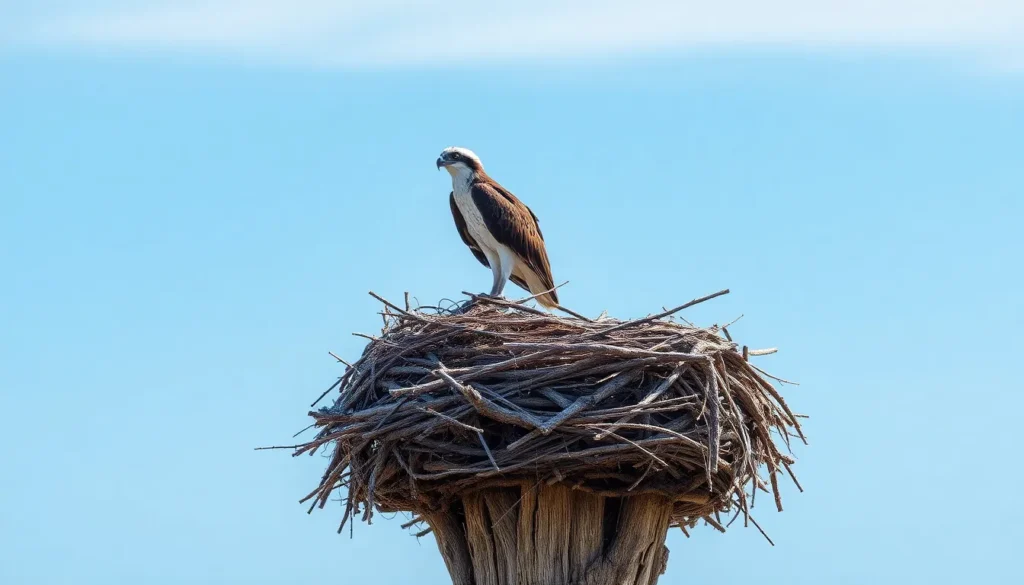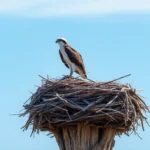We’ve all witnessed those breathtaking moments when a massive bird plunges into water with surgical precision and emerges with a fish clutched in its talons. That’s the osprey – one of nature’s most skilled fishing machines and a true marvel of the avian industry.
These remarkable raptors have captured our imagination for centuries with their incredible hunting abilities and impressive wingspan that can reach up to six feet. Found on every continent except Antarctica, ospreys have adapted to thrive in diverse aquatic environments from coastal shores to inland lakes and rivers.
What makes these birds truly extraordinary isn’t just their fishing prowess – it’s their incredible comeback story. Once nearly extinct due to DDT poisoning, ospreys have made one of conservation’s greatest success stories. We’re about to dive deep into the intriguing area of these “fish hawks” and discover why they’re considered one of the most successful raptor species on Earth.
Physical Characteristics of the Osprey Bird
The osprey’s physical traits reflect millions of years of evolution as a specialized fish-hunting raptor. We can identify these magnificent birds through their distinctive size proportions and remarkable anatomical features designed specifically for their aquatic lifestyle.
Size and Build
Ospreys measure 21 to 23 inches in length from head to tail. Their wingspan ranges from 59 to 71 inches, creating an impressive silhouette against the sky. Adult birds weigh between 3 to 4.4 pounds, with females typically larger than males by approximately 20%. The osprey’s body structure features a compact torso and proportionally long wings that provide exceptional lift and maneuverability over water surfaces.
Males average 1.4 to 1.8 kg while females reach 1.6 to 2 kg in weight. Their leg bones are notably robust, measuring 15% thicker than other raptors of similar size. The osprey’s skeletal frame supports powerful flight muscles that comprise 25% of their total body weight.
Distinctive Plumage and Markings
Brown and white coloration dominates the osprey’s appearance with dark chocolate-brown upperparts contrasting sharply against pure white underparts. We observe a distinctive white head marked by a prominent dark eye stripe that extends from the beak through the eye to the neck. This facial pattern helps reduce glare from water surfaces during hunting.
Juvenile ospreys display cream-colored edges on their back feathers, creating a scaled appearance that distinguishes them from adults. Their tail feathers show alternating dark and light bands with a broader terminal band. Adult birds maintain consistent plumage year-round without seasonal variations in coloring.
Unique Adaptations for Fishing
Reversible outer toes allow ospreys to grasp fish with two toes forward and two backward, creating an optimal grip configuration. Their talons curve sharply and measure up to 2 inches in length with needle-sharp points that penetrate fish scales. Specialized scales called spicules cover the bottom of their feet, providing additional traction on slippery prey.
Dense, oily feathers create waterproof barriers that prevent water penetration during fishing dives. Their nostrils feature closeable valves that seal automatically when the bird enters water. The osprey’s eyes contain specialized membranes that reduce underwater refraction, allowing accurate depth perception when targeting fish below the surface.
Habitat and Geographic Distribution
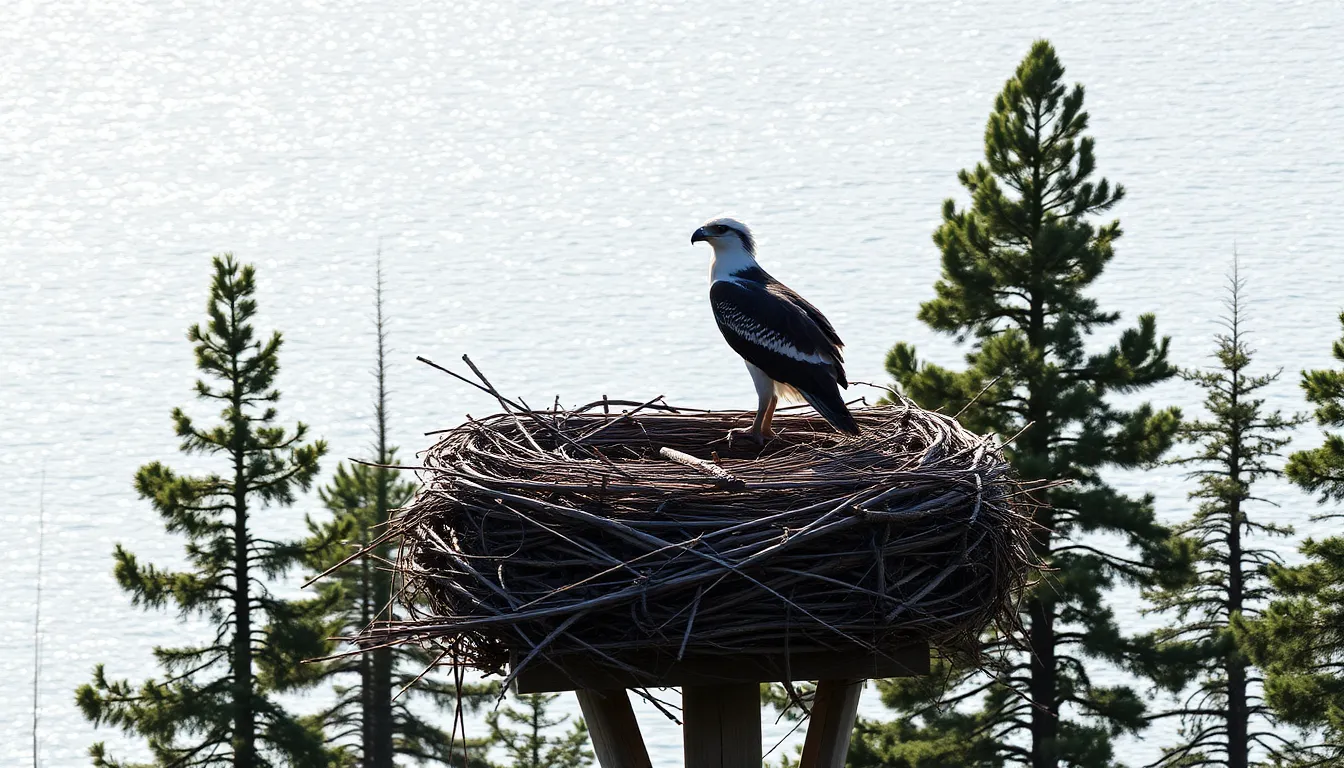
Ospreys demonstrate remarkable adaptability in their habitat selection, thriving in diverse aquatic environments across nearly every continent. These exceptional raptors establish territories wherever fish populations remain abundant and suitable nesting sites exist nearby.
Preferred Nesting Locations
Ospreys construct their massive nests on elevated structures that provide clear views of surrounding water bodies. Natural sites include tall trees such as pines, spruces, and dead snags located within 1.5 miles of fishing waters. Coastal populations favor rocky outcrops, sea stacks, and cliff faces that offer protection from predators and weather.
Human-made structures increasingly serve as osprey nesting platforms across their range. Cell towers, power line poles, navigation markers, and specially constructed platforms accommodate growing populations in developed areas. Urban ospreys adapt remarkably well to bridges, stadium lights, and even construction cranes in waterfront cities.
Successful nests typically sit 50 to 200 feet above ground level and feature sturdy foundations capable of supporting structures weighing up to 1,000 pounds. Pairs return to the same nest annually, adding new materials each breeding season and creating monuments that can reach 6 feet in diameter.
Global Range and Migration Patterns
Ospreys inhabit every continent except Antarctica, making them one of the most widely distributed bird species on Earth. Their global population spans temperate and tropical regions from 70°N latitude to 40°S latitude, covering approximately 6 million square miles of suitable habitat.
| Region | Breeding Population | Migration Distance |
|---|---|---|
| North America | 460,000 pairs | Up to 5,000 miles |
| Europe | 11,000 pairs | Up to 3,700 miles |
| Asia | 25,000 pairs | Up to 4,300 miles |
| Australia | 25,000 pairs | Non-migratory |
Northern populations undertake extensive migrations to reach wintering grounds in Central America, South America, Africa, and Southeast Asia. North American ospreys travel remarkable distances, with some individuals covering over 160,000 miles during their lifetime migrations. European birds winter primarily in West Africa, while Asian populations move to India, Southeast Asia, and Indonesia.
Breeding territories cover freshwater lakes, rivers, reservoirs, coastal estuaries, and marine environments. Ospreys demonstrate remarkable site fidelity, with adults often returning to natal areas to establish breeding territories within 30 miles of their birth location.
Diet and Hunting Behavior
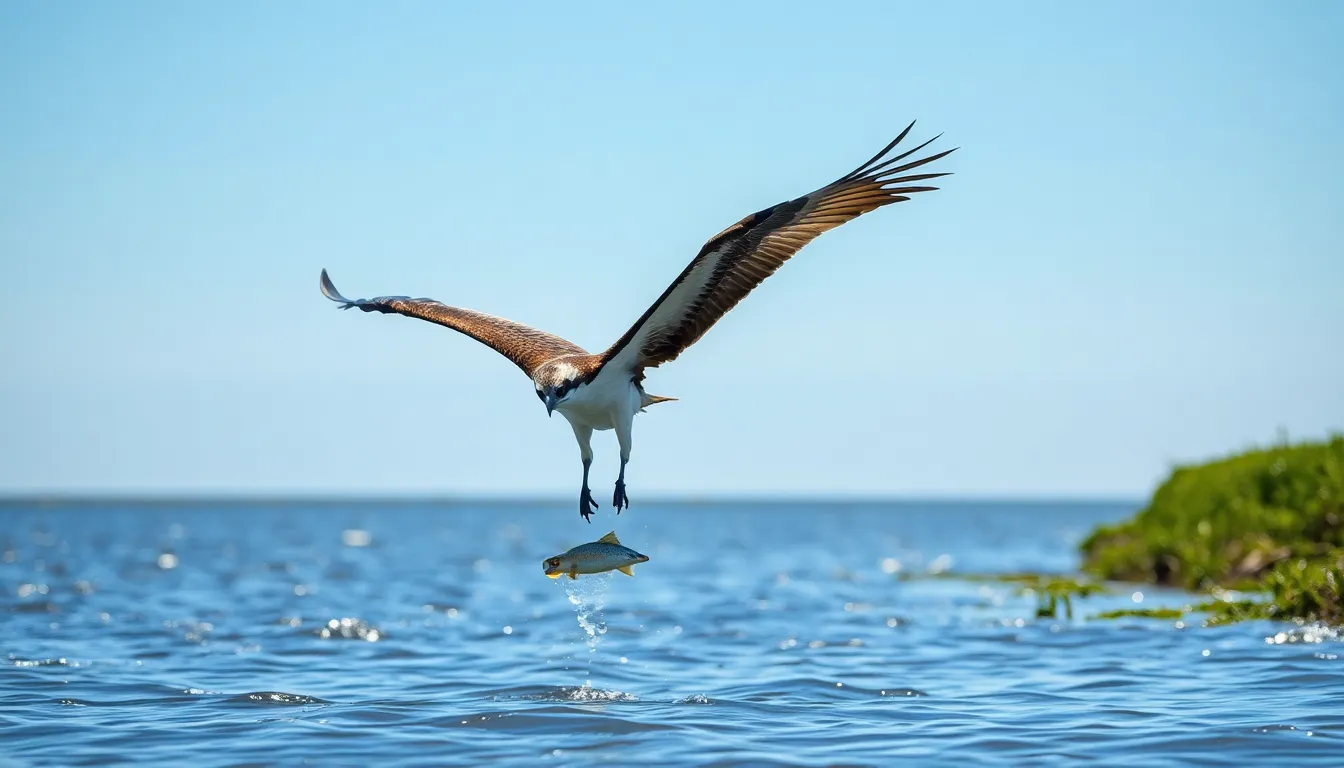
Ospreys demonstrate unparalleled expertise as fish-eating raptors, with 99% of their diet consisting of fish species. Their hunting prowess combines remarkable precision with specialized adaptations that make them one of nature’s most efficient aquatic predators.
Fishing Techniques and Success Rate
Fishing success for ospreys reaches 70-80% catch rates when environmental conditions remain optimal. We observe three distinct hunting methods employed by these skilled predators: hover fishing, perch hunting, and direct plunge techniques.
Hover fishing represents the most common approach, where ospreys maintain stationary flight positions 30-130 feet above water surfaces while scanning for prey movement. Birds execute this technique for 3-10 minutes before either diving or moving to new locations.
Perch hunting involves ospreys positioning themselves on elevated structures like dead trees, poles, or rocks overlooking productive fishing areas. This energy-efficient method allows extended observation periods with minimal physical exertion.
Direct plunge dives showcase the osprey’s most dramatic fishing technique, with birds descending at speeds reaching 50 mph from heights up to 200 feet. Their specialized nostrils close during dives to prevent water entry, while dense plumage provides buoyancy for surface recovery.
Successful catches depend on water clarity, fish behavior, and weather conditions. Ospreys achieve higher success rates during early morning and late afternoon periods when fish activity peaks near surface waters.
Prey Selection and Feeding Habits
Fish species selection varies geographically but typically includes abundant shallow-water species measuring 6-16 inches in length. Common prey includes trout, bass, pike, flounder, mullet, and carp across different regions.
Size preferences target fish weighing 150-300 grams, though ospreys can capture prey up to 2.5 pounds when necessary. Larger fish require extended handling time and increased energy expenditure during transport to feeding locations.
Seasonal variations influence prey availability and selection patterns. Spring migrations coincide with fish spawning activities, providing abundant feeding opportunities. Summer months offer consistent prey availability in established territories, while autumn hunting focuses on building fat reserves for migration.
Daily consumption averages 300-400 grams of fish per adult osprey, requiring 2-3 successful catches during peak feeding periods. Parents feeding nestlings increase hunting frequency to 6-8 catches daily, delivering fresh fish every 2-3 hours to growing chicks.
Feeding behavior includes systematic prey handling where ospreys align fish headfirst for aerodynamic transport. Birds consume smaller catches immediately while carrying larger prey to secure feeding perches or nest sites for consumption.
Breeding and Nesting Patterns
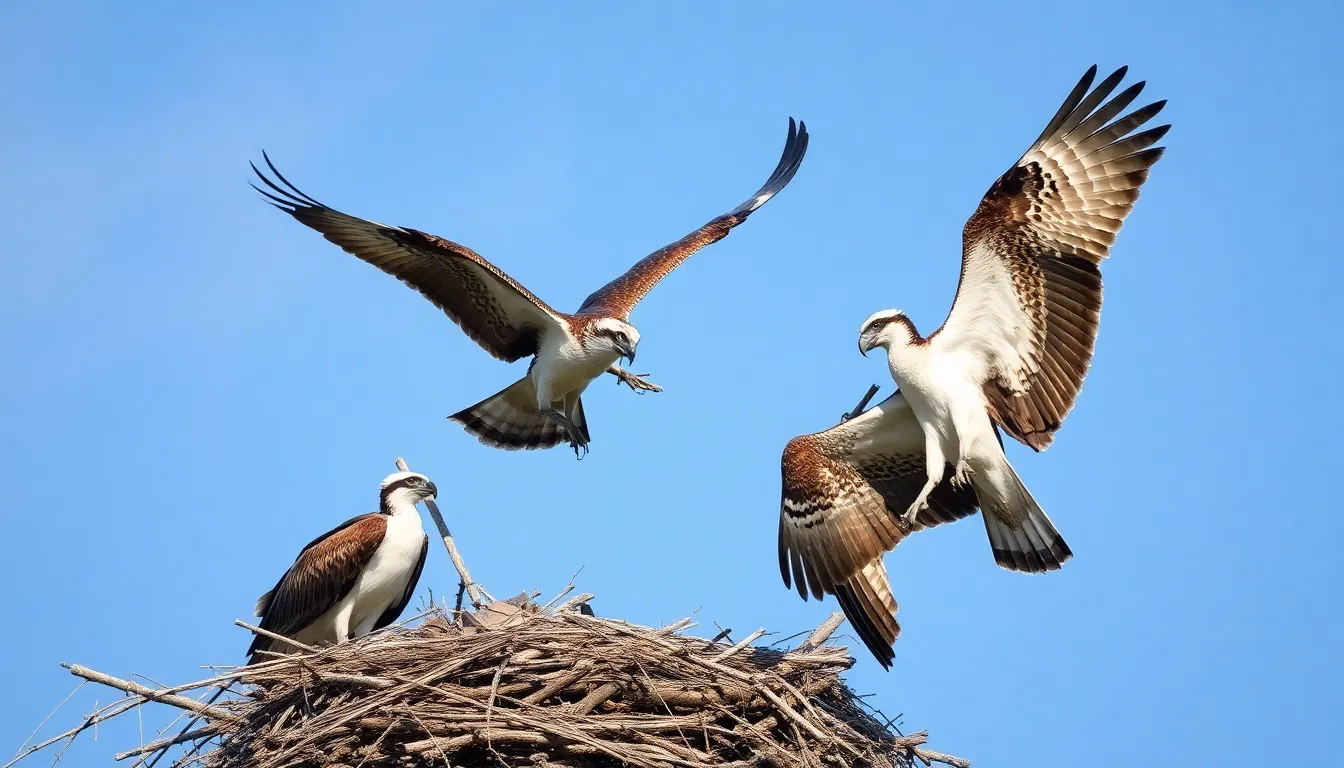
Osprey breeding patterns demonstrate remarkable consistency and dedication throughout their reproductive cycle. These magnificent raptors engage in elaborate courtship displays and maintain strong family bonds during their intensive nesting period.
Mating Rituals and Pair Bonding
Courtship displays begin when male ospreys arrive at breeding territories 1-2 weeks before females return from migration. Males perform spectacular aerial acrobatics including sky dancing, carrying fish or nesting materials while executing steep dives and climbs up to 300 feet above their intended nest site.
Pair bonding strengthens through mutual preening sessions and collaborative nest building activities. Established pairs typically reunite at the same nesting location annually, maintaining partnerships that can last 5-8 years or until one mate dies.
Gift giving behaviors reinforce these partnerships as males present fresh fish to females throughout the courtship period. Females evaluate potential mates based on territorial quality, nest site security, and consistent food provisioning demonstrations.
Nest Construction and Egg Laying
Construction begins with males gathering large sticks measuring 2-4 feet in length to form the nest foundation. Both partners contribute materials including branches, seaweed, rope, plastic debris, and soft grasses to create a sturdy platform structure.
Active nests expand continuously as pairs add 1-2 feet of new materials each breeding season. Established nests can weigh over 1,000 pounds after multiple years of additions and reach heights of 10-13 feet.
| Breeding Timeline | Activity | Duration |
|---|---|---|
| Nest building | Material gathering | 2-3 weeks |
| Egg laying | 2-4 eggs deposited | 3-5 days |
| Incubation period | Continuous brooding | 35-42 days |
| Nestling stage | Chick rearing | 48-58 days |
Females lay 2-4 cream colored eggs with brown blotches at 1-2 day intervals during late April through early June. Egg dimensions average 2.4 inches long and 1.8 inches wide, weighing approximately 65 grams each.
Chick Development and Parental Care
Incubation duties split between both parents with females handling 70% of brooding responsibilities. Males maintain primary hunting roles while females rarely leave the nest during the first 2 weeks after hatching.
Newly hatched chicks weigh 50-60 grams and remain covered in fluffy gray down feathers for their first 3 weeks. Growth rates accelerate rapidly as chicks gain 50-70 grams daily during peak development phases.
Feeding frequency increases dramatically with parents delivering fresh fish every 2-3 hours during daylight periods. Adult ospreys consume 15-20% more fish during breeding season to meet increased energy demands from constant provisioning.
Fledgling preparation begins around day 45 when young ospreys start exercising their wings and practicing short flights above the nest platform. Flight training continues for 2-3 weeks after initial fledging as parents gradually reduce feeding frequency to encourage hunting independence.
Conservation Status and Threats

Osprey populations demonstrate one of conservation’s greatest success stories, recovering from near extinction to stable numbers worldwide. The species currently maintains a conservation status of “Least Concern” according to the International Union for Conservation of Nature.
Population Recovery Success Stories
DDT pesticide bans across North America and Europe during the 1970s enabled osprey populations to rebound dramatically from critically low numbers. North American breeding pairs increased from fewer than 8,000 pairs in 1970 to over 240,000 pairs by 2019, representing a 30-fold population increase within five decades.
European osprey recovery efforts produced equally impressive results through targeted reintroduction programs. Scotland’s osprey population grew from zero breeding pairs in 1916 to more than 300 pairs by 2020, while Scandinavia supports approximately 11,000 breeding pairs across Norway, Sweden, and Finland.
Artificial nesting platforms contributed significantly to population recovery by providing secure breeding sites in areas lacking suitable natural structures. Wildlife management agencies installed over 15,000 platform structures across North America, with occupancy rates reaching 85% in optimal habitat locations.
Captive breeding and translocation programs restored osprey populations in previously vacant territories throughout their historical range. Germany’s successful reintroduction efforts established 700 breeding pairs by 2018, while France achieved similar success with 50 active pairs after local extinction in the 1960s.
| Region | 1970 Population | 2020 Population | Recovery Rate |
|---|---|---|---|
| North America | 8,000 pairs | 240,000 pairs | 3,000% increase |
| Scotland | 0 pairs | 300 pairs | Complete restoration |
| Germany | 0 pairs | 700 pairs | Complete restoration |
| Scandinavia | 5,000 pairs | 11,000 pairs | 220% increase |
Current Environmental Challenges
Climate change affects osprey breeding success through altered precipitation patterns that impact fish availability in freshwater systems. Extended drought periods reduce water levels in lakes and rivers, concentrating fish populations but making them less accessible to diving ospreys.
Habitat loss continues threatening osprey populations even though overall recovery trends, particularly in coastal areas experiencing rapid development pressure. Waterfront construction eliminates traditional nesting trees while increasing human disturbance around active nest sites.
Ocean plastic pollution creates indirect threats to osprey survival through contaminated fish consumption and entanglement risks from discarded fishing gear. Marine debris affects approximately 15% of osprey wintering grounds along Central and South American coastlines.
Wind energy development poses collision risks for migrating ospreys, with turbine strikes accounting for an estimated 2,000 annual deaths across major migration corridors. Strategic turbine placement and seasonal shutdown protocols reduce mortality rates by 40% in high-risk areas.
Illegal persecution persists in some regions where ospreys compete with commercial fishing interests or face cultural misconceptions about their impact on fish populations. Annual shooting deaths affect approximately 3,000 individuals across European and Asian ranges even though protective legislation.
Human disturbance during critical breeding periods causes nest abandonment and reduced reproductive success rates. Recreational boating, photography, and development activities within 300 meters of active nests decrease hatching success by up to 25%.
Observing Osprey Birds in the Wild

Successful osprey observations require strategic timing and location selection to maximize encounter opportunities. Understanding their behavior patterns enhances our ability to witness these remarkable fishing raptors in their natural environment.
Best Times and Locations for Spotting
Prime osprey viewing occurs during morning hours from 7:00 AM to 10:00 AM when these fish-eating raptors actively hunt in calm water conditions. Late afternoon sessions between 4:00 PM and 6:00 PM provide secondary opportunities as adults return to nests with catches for their young.
Coastal areas offer exceptional viewing opportunities, particularly near estuaries, bays, and shallow marine waters where fish concentrate in accessible depths. Large freshwater bodies including reservoirs, lakes, and major rivers consistently attract osprey populations throughout their active seasons.
We find the most productive locations include:
- Nesting platforms constructed specifically for ospreys on poles 50-80 feet high
- Bridge structures spanning waterways where pairs establish territories
- Dead tree snags along shorelines providing natural perching sites
- Fishing piers extending into productive waters
Spring migration periods from March through May concentrate returning breeding pairs at traditional nesting territories. Summer months from June through August showcase active family groups with frequent fishing displays and nestling feeding behaviors.
Behavioral Cues to Watch For
Distinctive flight patterns signal osprey presence before visual identification becomes possible. Steady wingbeats alternating with brief gliding phases characterize their fishing approach flights, distinguishing them from other large raptors in the area.
Hovering behavior above water surfaces indicates active hunting mode, with birds maintaining stationary positions 30-100 feet above potential prey. This technique precedes their signature plunge dives, which create dramatic splashes visible from considerable distances.
Key behavioral indicators include:
| Behavior | Description | Duration | Frequency |
|---|---|---|---|
| Fish carrying | Adults transport prey headfirst to nests | 2-15 minutes | 3-6 times daily |
| Territorial calls | Sharp whistling sounds near nesting areas | 10-30 seconds | Throughout breeding season |
| Nest maintenance | Adding sticks and materials to platforms | 15-45 minutes | Daily during active season |
| Perch hunting | Stationary observation from elevated positions | 5-60 minutes | Multiple sessions daily |
Successful fishing attempts result in characteristic shaking behavior as ospreys remove excess water from their waterproof plumage. Adults carrying fish demonstrate distinctive flight postures, with prey positioned aerodynamically to reduce drag during transport to nesting sites.
Alarm calls intensify when potential threats approach nesting territories, creating opportunities to locate active breeding pairs through auditory cues. Parent birds circle overhead while vocalizing repeatedly, often joined by their mates in coordinated defensive displays.
Conclusion
We’ve witnessed how the osprey stands as one of nature’s most remarkable success stories. Their journey from near extinction to thriving populations across the globe demonstrates the power of dedicated conservation efforts and environmental protection.
These magnificent birds continue to captivate us with their incredible adaptations and unwavering resilience. From their specialized fishing techniques to their impressive migration journeys spanning thousands of miles the osprey remains a testament to nature’s ingenuity.
As we move forward protecting osprey habitats and supporting ongoing conservation initiatives ensures future generations will witness these spectacular hunters in action. Their story reminds us that with proper stewardship even the most threatened species can make an extraordinary comeback.
Frequently Asked Questions
What is an osprey and where can they be found?
Ospreys are large raptors known for their exceptional fishing abilities, with wingspans reaching up to six feet. They’re found on every continent except Antarctica, thriving near aquatic environments wherever fish populations are abundant. These remarkable birds establish territories around coastlines, lakes, rivers, and reservoirs worldwide, demonstrating impressive adaptability in habitat selection.
How big are ospreys and what do they look like?
Ospreys measure 21-23 inches in length with wingspans of 59-71 inches. They feature distinctive brown and white plumage, with dark brown upperparts and white underparts. Their heads display unique facial markings including a white crown and dark eye stripe, which aids in hunting by reducing glare from water surfaces.
What makes ospreys such successful fishermen?
Ospreys have specialized adaptations including reversible outer toes for optimal grip, sharp curved talons, waterproof feathers, and enhanced eyesight for spotting fish underwater. They achieve a 70-80% fishing success rate using three hunting techniques: hover fishing, perch hunting, and dramatic plunge dives reaching speeds of 50 mph.
What do ospreys eat and how often do they hunt?
Fish comprises 99% of an osprey’s diet, typically targeting shallow-water species measuring 6-16 inches like trout, bass, and carp. Adult ospreys consume 300-400 grams of fish daily. During breeding season, parents increase hunting frequency to feed nestlings, delivering fresh fish every 2-3 hours to meet their growing energy needs.
Where and how do ospreys build their nests?
Ospreys construct massive nests on elevated structures 50-200 feet above ground, including tall trees and human-made platforms. These nests can reach 6 feet in diameter, weigh over 1,000 pounds, and stand 10-13 feet high. Pairs often return to the same nest annually, adding new materials each breeding season.
How far do ospreys migrate?
Northern osprey populations undertake extensive migrations to wintering grounds in Central America, South America, Africa, and Southeast Asia. Some individuals cover remarkable distances during their lifetime migrations, traveling thousands of miles between breeding and wintering territories. Southern populations may remain year-round residents in suitable climates.
What is the conservation status of ospreys?
Ospreys are currently classified as “Least Concern” by the IUCN, marking a remarkable conservation success story. After near extinction due to DDT poisoning, North American breeding pairs increased from fewer than 8,000 to over 240,000 by 2019 following the DDT ban in the 1970s.
What threats do ospreys currently face?
Current threats include climate change affecting fish populations, habitat loss from development, ocean plastic pollution, wind energy infrastructure, illegal persecution, and human disturbance during breeding periods. Despite stable populations, ongoing conservation efforts remain crucial for protecting these magnificent birds and their aquatic ecosystems.
When is the best time to observe ospreys in the wild?
Prime viewing times are during morning and late afternoon hours when ospreys are actively hunting or returning to nests. Look for them near coastal areas, large freshwater bodies, and nesting platforms. Key behavioral cues include distinctive flight patterns, hovering behavior above water, and distinctive alarm calls.
How do ospreys breed and raise their young?
Males perform elaborate courtship displays and aerial acrobatics to attract females. Established pairs often reunite annually for 5-8 years. Females lay 2-4 cream-colored eggs with shared incubation duties. Chicks grow rapidly, requiring fresh fish deliveries every 2-3 hours until they’re ready to fledge and become independent.

